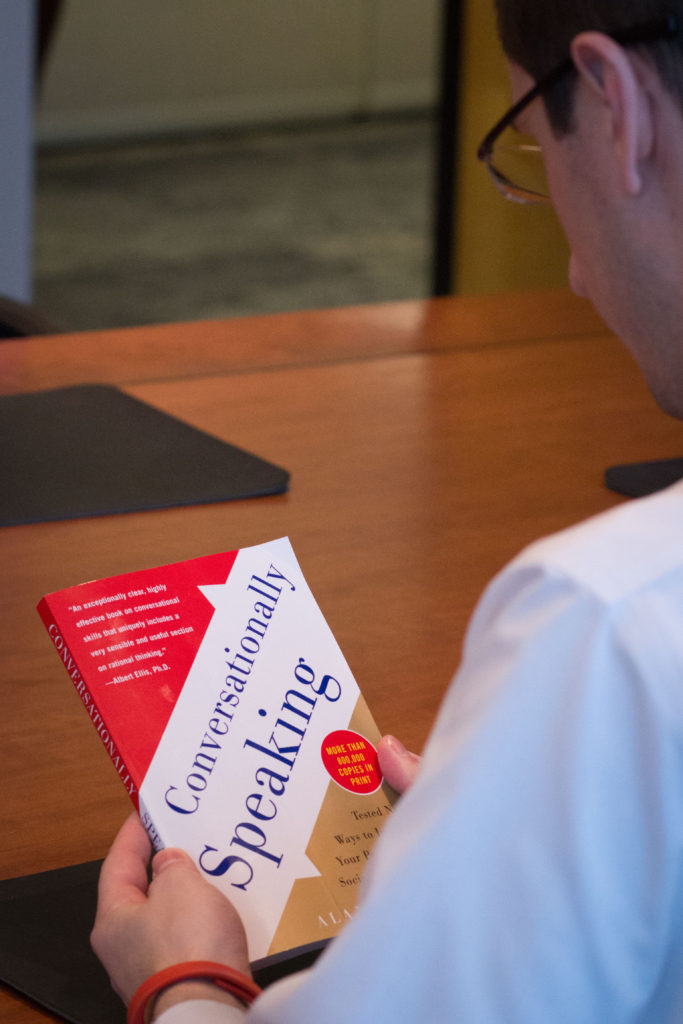The Xenium book club has dabbled in quite a variety of books over the past few years. From fables, such as The Leader Who Had No Title, philosophical books, like The Four Agreements, and even theory-based material, such as Start With Why, no business or self-help book is out of reach for us. For a recent group discussion, we decided on a self-help book called Conversationally Speaking: Tested New Ways to Increase Your Personal Social Effectiveness by Alan Garner.
I found the title to be slightly misleading in a sense that these aren’t really new ways at all–after all, this book was written in 1981 in an era where self-help books were plentiful. A lot of these ideas have been around for a long time and built upon by other authors and speakers. As a reader, you get an odd sense that you have read this book before. In fact, during the first three chapters of the book I felt as if I was reading How to Win Friends and Influence People again. Regardless of how this book might overlap with others like it, there were still some great takeaways I found useful, and I will share what I learned below:
How to Keep a Conversation Going
I had high hopes for Conversationally Speaking for the simple fact the very first chapter offered a simple, yet profound idea, which is the notion of open-ended versus closed-ended questions. Open-ended questions can keep a conversation flowing and can often take a conversation to a place no one anticipated, whereas closed-ended questions often end with a “yes” or “no” answer at which point someone then has to jump-start the conversation by asking another question, talking about themselves, or stating a fact. Here is an example:
Closed-ended: “Do you go jogging?”
Obviously a question of this nature will be greeted with a yes or no and halts the conversation. A definite route to an awkward conversation.
Open-ended: “Why do you go jogging?”
Altering the question ever-so-slightly by adding a “how,” “why,” or “in what way” can expand the question to the point it can open up a realm of possibilities in the answer.
I admit, after reading this chapter I immediately started paying attention to how I was asking questions both at work and with my family.
How to Encourage the Behavior You Want
The author provided a story about a teacher who would regularly run into a student of his on campus. He explained how the student would always find a way to complain about something, whether it was the weather, how he hated his job and many other things. The teacher then decided that in future interactions he would make a point to ignore the student as he spoke negatively and only responds when he would say something positive. The author calls this “delivering positives.” In this story, the teacher’s hope was that the  student’s behavior would begin to change around him since the teacher would only reward the positive attitude instead of the negative. Over time, it ended up working and the student would speak positively around the teacher. To the author’s point, it is highly likely the student still spoke negatively, just not around the teacher since he was able to shape his student’s behavior around him.
student’s behavior would begin to change around him since the teacher would only reward the positive attitude instead of the negative. Over time, it ended up working and the student would speak positively around the teacher. To the author’s point, it is highly likely the student still spoke negatively, just not around the teacher since he was able to shape his student’s behavior around him.
Whether or not this can work is unknown to me, but I thought it brought up a great point. Often we put more emphasis on the negative than the positive, and doing so can negatively shape behavior. For example, a child brings home a report card with 1 A, 4 B’s and a C, and the parent asks why she got a C instead of focusing on what she did great at. Maybe, then, the child feels discouraged in that subject with the C and/or never feels she can be good enough for her parents. What we do and say can absolutely have an effect on other people, and this point drilled that home for me.
Taking Advantage of Free Information
Open-ended questions can spark a plethora of new information that otherwise wouldn’t have been on the table during a conversation. Using information shared in conversation can show the other person that you are listening and give you a chance to ask follow up questions based on the information given away. Here’s an example from the book:
Glen: “You have a nice tan, Billy.”
Billy: “Thanks, Glen. I got it camping this weekend with Doreen.”
Glen: “I’ve never been camping and I’m curious to know what you enjoy most about it.”
See what Glen did? Billy gave away information about where he got the tan (camping) and Glen decided to use it and follow up with a comment and a question. So often in our daily conversations people provide little nuggets of free information that we can use to expand the conversation but we either choose not to or we aren’t listening intently enough to catch it.
I think books like Conversationally Speaking can and will live on throughout time. Here’s why:
- The book is short (198 pages) and not full of unnecessary content or, as I say, “fluff.”
- The ideas are simple to understand and easy to apply.
- With the internet and all of our social tools, we are always so connected with people online yet less practiced at having effective conversations in person. This book helps the reader break down the social anxiety and awkwardness of in-person conversations.
When I look at the book as a whole, it wasn’t mind-blowing or even one of the best books I have read this year. In fact, the issues I had with the book were mostly with how it read—which was like a manual (i.e. it was boring at times). What I will say about it is that the ideas I did glean from the book have actually stuck with me and inspired me to take action–and I can’t necessarily say that about the other books I have read recently. Is it worth reading? Yes, absolutely. It’s short, sweet and something you can come back to easily since the chapters are bite-sized. The book is also great as a discussion or when used in a workshop about working with others.
Check out my rating of Conversationally Speaking and my full reading list on Goodreads. Happy reading!
-Brandon
![]()

We are giving away 2 free copies
of Conversationally Speaking!
Click below to enter the drawing.
Deadline to enter: December 16

